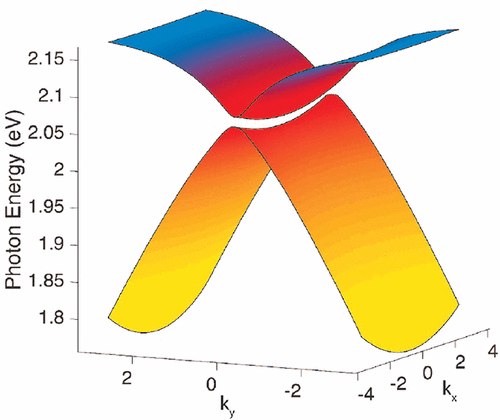当前位置:
X-MOL 学术
›
ACS Photonics
›
论文详情
Our official English website, www.x-mol.net, welcomes your feedback! (Note: you will need to create a separate account there.)
Dispersion Anisotropy of Plasmon–Exciton–Polaritons in Lattices of Metallic Nanoparticles
ACS Photonics ( IF 7 ) Pub Date : 2017-11-08 00:00:00 , DOI: 10.1021/acsphotonics.7b00661 Mohammad Ramezani 1 , Alexei Halpin 1 , Johannes Feist 2 , Niels Van Hoof 1 , Antonio I. Fernández-Domínguez 2 , Francisco J. Garcia-Vidal 2, 3 , Jaime Gómez Rivas 1, 4
ACS Photonics ( IF 7 ) Pub Date : 2017-11-08 00:00:00 , DOI: 10.1021/acsphotonics.7b00661 Mohammad Ramezani 1 , Alexei Halpin 1 , Johannes Feist 2 , Niels Van Hoof 1 , Antonio I. Fernández-Domínguez 2 , Francisco J. Garcia-Vidal 2, 3 , Jaime Gómez Rivas 1, 4
Affiliation

|
When the electromagnetic modes supported by plasmonic-based cavities interact strongly with molecules located within the cavity, new hybrid states known as plasmon–exciton–polaritons (PEPs) are formed. The properties of PEPs, such as group velocity, effective mass, and lifetime, depend on the dispersive and spectral characteristics of the optical modes underlying the strong coupling. In this work, we focus on lattice modes supported by rectangular arrays of plasmonic nanoparticles known as surface lattice resonances (SLRs). We show that SLRs arising from different in-plane diffraction orders in the lattice can couple with the molecular excitons, leading to PEPs with distinct dispersions and thus different group velocities. These results illustrate the possibility of tailoring the transport of PEPs through the design of lattices of plasmonic particles.
中文翻译:

等离子-激子-紫胶在金属纳米颗粒晶格中的分散各向异性
当基于等离激元的腔所支持的电磁模式与位于腔内的分子强烈相互作用时,就会形成称为等离激元-激子-极化子(PEP)的新混合态。PEP的属性,例如群速度,有效质量和寿命,取决于强耦合背后的光学模式的色散和光谱特性。在这项工作中,我们专注于由等离子纳米粒子的矩形阵列支持的晶格模式,称为表面晶格共振(SLR)。我们表明,由晶格中不同的平面内衍射级引起的SLR可以与分子激子耦合,从而导致PEP具有不同的分散度,从而具有不同的基团速度。
更新日期:2017-11-08
中文翻译:

等离子-激子-紫胶在金属纳米颗粒晶格中的分散各向异性
当基于等离激元的腔所支持的电磁模式与位于腔内的分子强烈相互作用时,就会形成称为等离激元-激子-极化子(PEP)的新混合态。PEP的属性,例如群速度,有效质量和寿命,取决于强耦合背后的光学模式的色散和光谱特性。在这项工作中,我们专注于由等离子纳米粒子的矩形阵列支持的晶格模式,称为表面晶格共振(SLR)。我们表明,由晶格中不同的平面内衍射级引起的SLR可以与分子激子耦合,从而导致PEP具有不同的分散度,从而具有不同的基团速度。



























 京公网安备 11010802027423号
京公网安备 11010802027423号